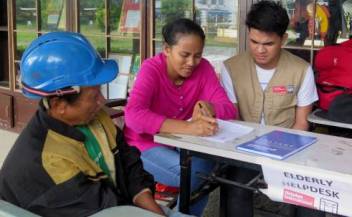 Typhoon Hagupit, the equivalent of a Category 3 hurricane, affected 2.9 million people and reportedly destroyed about 1,000 homes across the Philippines.
Typhoon Hagupit, the equivalent of a Category 3 hurricane, affected 2.9 million people and reportedly destroyed about 1,000 homes across the Philippines.
Clare Harris, Disaster Risk Reduction Resilience Advisor at HelpAge International, discusses the lessons learned from Typhoon Haiyan a year ago, and how people prepared this time:
Typhoon Hagupit should be heralded as a good news story in terms of disaster risk reduction, but there’s still a lot to do in terms of building resilient systems and how we access recovery services.
Compared with last year when 7,000 people lost their lives in Typhoon Haiyan, an estimated 21 people were killed as a result of Typhoon Hagupit. However, these were old or very young, showing that we still have a long way to go to ensure disaster preparedness is age-inclusive.
More DRR education needed
One of the main reasons so many people died last year was a lack of understanding of the forecast. A storm surge was predicted, but many didn’t understand what that meant exactly. This highlights the fact that education on disaster risk reduction (DRR) must improve. This year, the authorities and communities understood they needed to move away from coastal areas.
When the warnings came, people moved into shelters, but these were not well equipped. Reports said that people were running out of food, as stocks were bought up.
Thousands of people in the Philippines are still affected in terms of power and telecommunications. Truly successful disaster risk reduction means that people don’t lose their livelihoods and are able to recover quickly.
Done well, action at community level with government support in disaster management, from evacuation to shelter to rehabilitation, means the impact on communities is short lived.
DRR planning starts at community level
People’s memories of disasters tend to help resilience, as unsurprisingly, more frequent events can make people more resilient. When there are large gaps between disasters, people can become complacent.
This is particularly so with earthquakes. Even if people are aware of an earthquake risk, if it’s not within their living memories, it can make the risk seem less real.
The key to disaster risk reduction is to educate people on what the risks are and make sure mitigation and preparedness actions are in place.
We need to commit equally to early evacuation and early warning systems, as well as community DRR planning. A much stronger emphasis should also be placed on resilient societies and systems so that infrastructure losses are reduced. This should include strengthening buildings and better planning of land use.
It shouldn’t be the norm that everyone loses their house each time a disaster strikes. Payment and road systems need to be prioritised, as well as evacuation, so that life after a disaster can continue to function and the impact is reduced.
Resilient livelihoods
Attention also needs to be focused on resilient livelihoods, through diversifying and strengthening, so there is some level of insurance.
Pastoralists, for instance, in droughts, de-stock their herd by keeping the strongest cattle and drying the slaughtered meat to help them through a difficult period.
Mobility, flexibility, protecting assets and insurances are all elements which can make a source of income more resilient.
Download our Building disaster resilience of older people Global AgeWatch brief.
Read more on the UNOCHA Philippines disaster management website.
